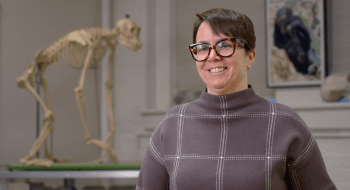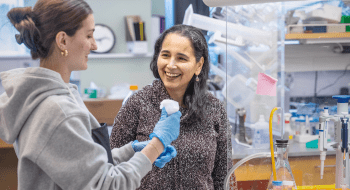
Anthropology Prof., Students Exhume Skeletal Remains in Heuvelton
When the Village of Heuvelton began a project to replace its existing water tower, construction crews stumbled onto something rather unexpected: skeletal remains. That’s when St. Lawrence University’s Mindy Pitre, associate professor of anthropology and J. Ansil Ramsay Professor of Public Health, received a call from the St. Lawrence County Sheriff’s Department.
“While crews were digging a new water main leading from the street towards the existing water tower they discovered human remains,” said Pitre. According to Linda Wood, Village of Heuvelton and Oswegatchie historian, the site was once the village’s first cemetery, dating to as early as the 1850s. The cemetery was subsequently emptied, and its burials were thought to have been moved to nearby Hillcrest Cemetery in the late 1800s. Clearly, however, not all of the graves were removed, which was fairly common in such historical situations.
Pitre was called in as a bioarchaeological consultant—charged with excavating and analyzing any skeletal remains recovered—and is currently collaborating at the site with Tim Abel, Ph.D., a local archaeologist. Several of her students have also become involved.
“The project has thus far involved 20 SLU students, all of whom have background in human osteology through taking my courses,” Pitre said. “Students have been afforded a rare opportunity to experience anthropology in the field while at the same time doing the community a service.”
Shelby Little ’20, who is majoring in anthropology, relayed how working with Pitre is allowing her to hone her archaeological skills and to gain experience in a field that she hopes to enter after graduation.
At the site, Pitre and her students have been removing the skeletal remains of several individuals that were inadvertently discovered. In addition to human remains, the team has recovered coffin hardware such as nails, coffin screws, and hinges. Pitre said all of their work at the site is following standard bioarchaeological and New York State Historic Preservation protocols and is being carried out with the utmost respect for the discovered individuals.
The remains are being examined in Pitre’s St. Lawrence lab, where she is carrying out skeletal analysis to determine information such as sex, age, ancestry, height, and cause and manner of death. Once her analysis is complete, the human remains will be reburied in Hillcrest Cemetery.
Adam Hill, associate professor of chemistry at St. Lawrence, has also been involved, photo-documenting the water tower in advance of its removal from the site, thereby helping to preserve this iconic part of the village’s history. The project has multiple collaborators: as noted, this is a Village of Heuvelton project, partially funded by the USDA Rural Development, administered by Canton-based Capital Consultants Architecture & Engr (C2AE), in consultation with New York’s State Historic Preservation Office (SHPO).
“Efforts at the site have been incredibly collaborative and cooperative between all parties involved,” Pitre said. “It’s a win-win situation for everyone: Our students get an amazing experiential learning opportunity, and the community of Heuvelton has some of its early residents respectfully laid to rest.”



